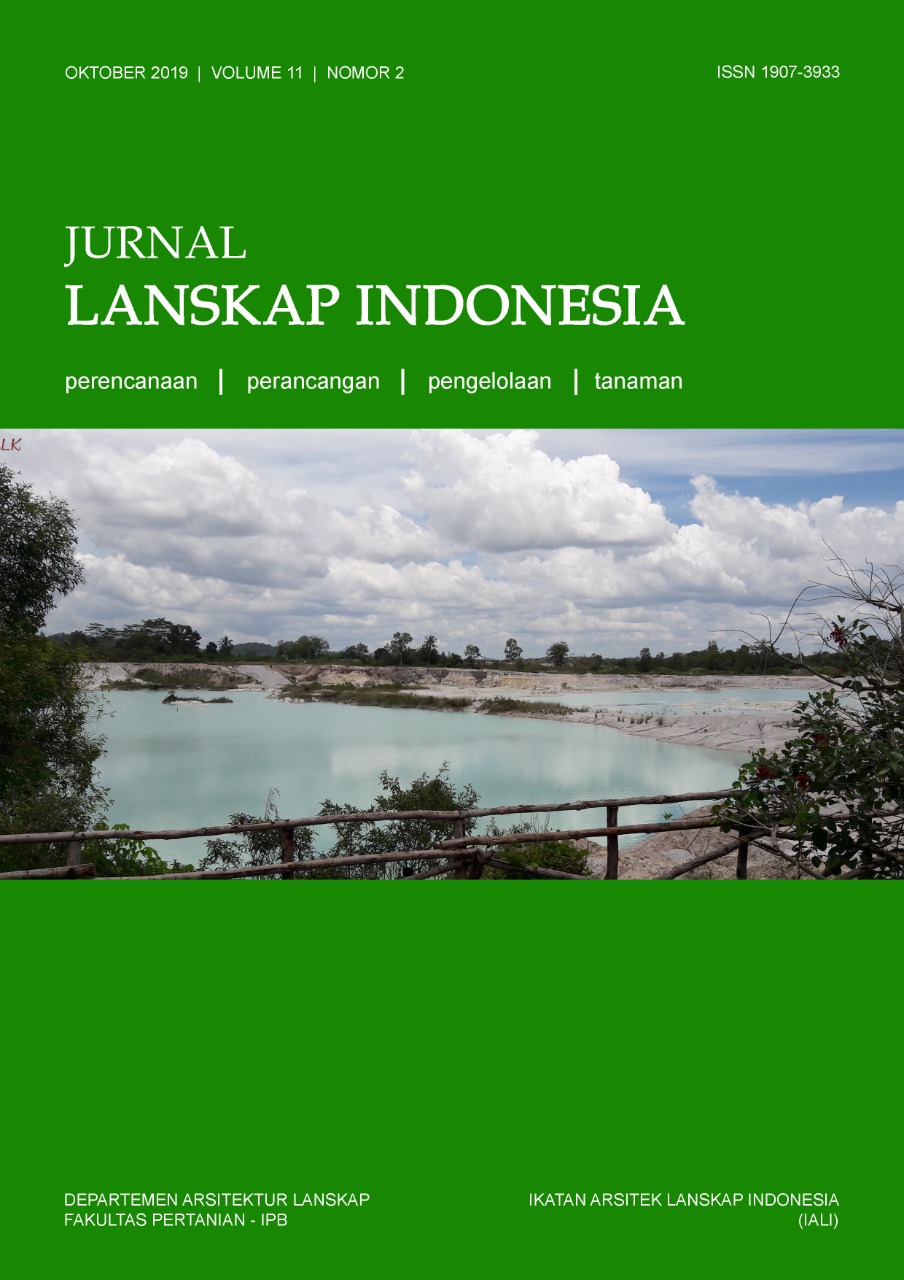Desain Taman Sekolah untuk Anak Berkebutuhan Khusus di Sekolah Alam Bogor
Abstract
The condition of a school landscape is important because it affects the learning process which can increase participation among students. Nature school is one form of an educational institution that takes account the importance of a landscape and how the students can appreciate the environment. One nature school is in Bogor, more specifically at Tanah Baru. This nature school has an inclusive education program for children with special needs, in which they can interact with other children of the same age. The aim of this research is to create a concept and design of the school landscape and playgrounds that can function as an educational and healing space through programs and activities that stimulate growth and development of children with environmental qualities and esthetics. The method that was used for this research was analyzing qualitative and quantitative aspects through three approaches that are biophysics, social, and education of special needs children. This method was done through four stages which are: (1) preparation stage, (2) research and analyzing the existing conditions (physical and biophysical) and educational process for special needs children through direct observation and literature review, (3) data processing stage, and (4) designing stage. The main concept of this school landscape is to create an educational and interactive landscape which can be used for therapeutic activities by combining the existing therapeutic activities. The main concept of this landscape comes from the concept “building blocks for learning” which consists of skills obtained from therapeutic activities. The design concept, “building blocks of life”, is a development from the main concept which can be interpreted as the compositional structure of all living things, in which cells are the lowest structural level of living things, as well as elementary school in the educational system. The output of this research is limited to the landscape design phase, with the final product in the form of a site plan and other supporting detail drawings.
Downloads
References
Booth, N.K. 1983. Basic Elements of Landscape Architectural Design. Waveland Press Inc: Illinois (US).
Badan Nasional Penanggulangan Bencana. 2012. Peraturan Kepala Badan Nasional Penanggulangan Bencana Nomor 4 Tahun 2012 tentang Pedoman Penerapan Sekolah/Madrasah Aman dari Bencana. Jakarta (ID): Badan Nasional Penanggulangan Bencana.
Emmanuel, R. 2005. Thermal comfort implications of urbanization in a warm-humid city: The Colombo Metropolitan Region (CMR), Sri Lanka. Building and Environment. 40: 1591-1601. DOI: https://doi.org/10.1016/j.buildenv.2004.12.004
Harris, C.W. Dines, N.T. 1998. Time-Saver Standards for Landscape Architecture: Design and Construction Data. McGraw-Hill Publishing Company: New York (US).
Hastuti. 2012. Psikologi Perkembangan Anak. Tugu Publisher: Yogyakarta (ID).
Hebert, B.B. 2003. Design Guidelines of Therapeutic Garden for Autistic Children [Thesis]. Louisiana State University and Agricultural and Mechanical College.
Suryana, D. 2016. Pendidikan Anak Usia Dini: Stimulasi dan Aspek Perkembangan Anak. Prenada Media: Jakarta (ID).
Talarosha, B. 2005. Menciptakan Kenyamanan Thermal dalam Bangunan. Jurnal Sistem Teknik Industri. 6(3): 148-158.
This journal permits and encourages authors to post items submitted to the journal on personal websites or institutional repositories both prior to and after publication, while providing bibliographic details that credit, if applicable, its publication in this journal. However, after the article is submitted and published in this journal, it is fully copyrighted by the Jurnal Lanskap Indonesia or JLI. If excerpts from other copyrighted works are included, the author must obtain written permission from the copyright owner and give credit to the source in the article. Then, the writer or reader is allowed to copy, share, and redistribute articles/material in any form. But it must still include the appropriate source and credit because the article in this journal is licensed by Creative Commons Attribution 4.0 International License (CC BY 4.0).
I. Proposed Policy for Journals That Offer Open Access
Authors who publish with this journal agree to the following terms:
- Authors retain copyright and grant the journal right of first publication with the work simultaneously licensed under a Creative Commons Attribution License that allows others to share the work with an acknowledgement of the work's authorship and initial publication in this journal.
- Authors are able to enter into separate, additional contractual arrangements for the non-exclusive distribution of the journal's published version of the work (e.g., post it to an institutional repository or publish it in a book), with an acknowledgement of its initial publication in this journal.
- Authors are permitted and encouraged to post their work online (e.g., in institutional repositories or on their website) prior to and during the submission process, as it can lead to productive exchanges, as well as earlier and greater citation of published work (See The Effect of Open Access).
II. Proposed Policy for Journals That Offer Delayed Open Access
Authors who publish with this journal agree to the following terms:
- Authors retain copyright and grant the journal right of first publication, with the work after publication simultaneously licensed under a Creative Commons Attribution License that allows others to share the work with an acknowledgement of the work's authorship and initial publication in this journal.
- Authors are able to enter into separate, additional contractual arrangements for the non-exclusive distribution of the journal's published version of the work (e.g., post it to an institutional repository or publish it in a book), with an acknowledgement of its initial publication in this journal.
- Authors are permitted and encouraged to post their work online (e.g., in institutional repositories or on their website) prior to and during the submission process, as it can lead to productive exchanges, as well as earlier and greater citation of published work (See The Effect of Open Access).



























